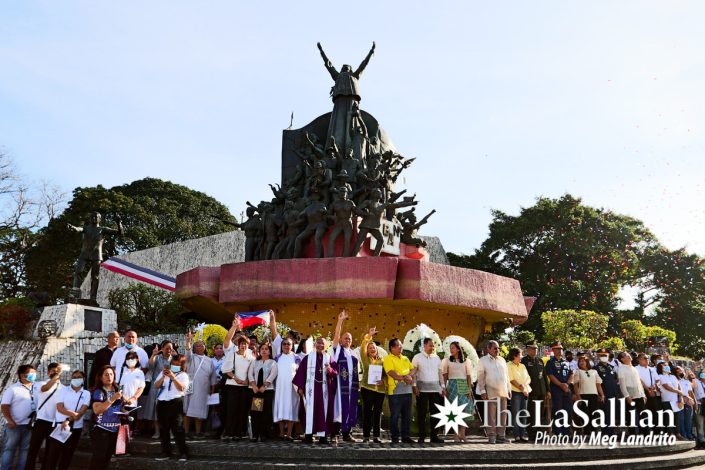The People Power Revolution on February 25, 1986 became a lasting reminder to the Filipino nation of the need for unification against an oppressive rule that ended with the toppling of former president and dictator Ferdinand Marcos Sr. However, on the 37th anniversary of the historic event, his son, Ferdinand Marcos Jr., is sitting as president, further empowering the commemoration’s message.

While there were less than a million Filipinos walking along the stretch of EDSA during this year’s commemoration, the event was able to garner at least 1,500 participants at the People Power Monument. United under the banner EDSA 37: Tuloy ang Laban para sa Hustisya, Kabuhayan, Kalayaan, at Demokrasya, the dissenting groups reminisced the struggles of the past while criticizing the new administration of the dictator’s namesake.
Sins of the father
Like past EDSA Revolution anniversaries, the commemoration of Filipinos’ united front in overcoming tyranny has always been the main theme. But unlike past commemorations, this one is the first under another Marcos administration. A myriad of veterans—those who originally participated in the 1986 revolution—came on stage not only to provide a glimpse of their experience under a dictatorial rule but to also warn of the possibilities with the dictator’s son leading the country.
Movement Against Disinformation Chairman Atty. Rico Domingo, who was a high school student at the University of the Philippines Integrated School at the time, recalled the moment the writ of habeas corpus was suspended in 1971. With Marcos Jr. as president, he said the country has “gone the full circle.” He declared, “The second Martial Law is oncoming.”
Another veteran at the event was Missionary Benedictine Sister Mary John Mananzan. She expressed her disappointment at Marcos Jr. taking up the mantle, even after successfully overthrowing his father in 1986. With the social injustices and issues happening in the younger Marcos’ administration, she pressed the youth to remain vigilant.
“Tayo’y dapat maging vigilant…hindi natin palalampasin ang kahit anong mga paglabag sa karapatan ng tao,” Mananzan exclaims.
(We should remain vigilant…we shall not ignore any crimes against human rights.)
Criticisms on the son
Halfway across the crowd of participants was a set of rallyists hailing from different sectors who had their fair share of opinions on Marcos Jr.’s administration.
Despite extending a “hand of reconciliation” during the event, the Philippine president was likened to a “tuta” of the United States. This comes after the news that four American bases are set to be installed in the country, following the expansion of the Enhanced Defense Cooperation Agreement.
“Nagkukunwari pa itong si Marcos Jr. na wala raw sinusunod na imperyalista ang Pilipinas, ngunit malaman-laman natin tahasan niyang inaprubahan ang dagdag [US] military bases sa ating bansa,” shares Gabriela Secretary General Clarice Palce.
(Marcos Jr. pretends that the Philippines does not follow any imperialist, but he blatantly approved the addition of US military bases in the country.)
Kilusang Mayo Uno National Chairperson Elmer Labog also denounced labor policies implemented by the Marcos Jr. administration, calling the president’s response to labor issues such as contractualization and low minimum wage as “bingi [at] barat sa hinaing ng mga manggagawa.”
(…deaf and stingy to the needs of workers.)
History’s spirit
Although respect for each other’s causes was evident during the event, the unifying purpose that brought organizations and spokespersons to call people to action was overshadowed by groups that had their own concerns to air. Even when the protest had just officially started, some groups conducted separate demonstrations—albeit with similar calls such as the implementation of a higher minimum wage, proper economic handling, and resistance against historical revisionism—in the nearby EDSA Shrine.
The participants’ advocacies in the EDSA anniversary seemed to become disjointed as a myriad of issues were raised without a unifying goal, which was the opposite of what Mananzan hoped the youth would realize in that same event. “‘Pag tayong mga mamamayan ay nagkakaisa sa isang layunin, ang parang imposibleng mangyari [ay] nangyayari,” she stressed.
(When we citizens unite for a common goal, the seemingly impossible becomes possible.)
With issues such as “historical distortion” overshadowing important facts about Martial Law—something warned of by DLSU Department of History Assistant Professorial Lecturer Xiao Chua, who was also in attendance—it becomes even more important to remain vigilant and remind people what the 1986 revolution was, as remembering what Filipinos fought for 37 years ago would come a long way in uniting for a common goal.
Chua shared, “Hindi tayo pasisiil. Magkaisa tayo para magkaroon ng pagbabago ang mamamayang Pilipino na [magkakasama]. Iyan ang kapangyarihan [ng EDSA Revolution].”
(We will not be oppressed. We must unite to make change for the common Filipino. That is the power of the EDSA Revolution.)
